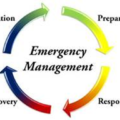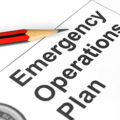An emergency is a situation that poses an immediate risk to health, life, property, or environment. Most emergencies require urgent intervention to prevent a worsening of the situation, although in some situations, mitigation may not be possible and agencies may only be able to offer palliative care for the aftermath.
While some emergencies are self-evident (such as a natural disaster that threatens many lives), many smaller incidents require that an observer (or affected party) decide whether it qualifies as an emergency. The precise definition of an emergency, the agencies involved and the procedures used, vary by jurisdiction, and this is usually set by the government, whose agencies (emergency services) are responsible for emergency planning and management.
Emergency Management Definition
Emergency planning management refers to the coordination and management of resources and responsibilities pertaining to the mitigation of, preparedness for, response to, and recovery from an emergency. This includes the gathering, management, and analysis of big data for the purpose of integrating a data-driven approach into each phase of the emergency management cycle.
What is Emergency Management?
The ultimate goal of an emergency management plan is to provide a data-driven framework that helps communities recognize and reduce vulnerabilities, cope with the aftermath of a disaster, and further develop disaster response plans. Big data in disaster management uses the analysis of information gathered from an affected community in real-time in order to improve the efficiency and effectiveness of emergency management response teams.
Disaster management data collection and emergency management software facilitate innovative emergency management endeavors such as crisis mapping, social media mining, and event simulations, which use enormous volumes of real-time and historical data to assist emergency management directors and their teams in developing proactive, protective strategies. Very large batches of data improve emergency preparedness with disaster management data analysis of statistics from previous disasters, which is feasible with the use of big data analytics platforms that can produce instant insights.
Emergency management principles dictate that an emergency and disaster management plan must be: Comprehensive; Progressive; Risk-Driven; Integrated; Collaborative; Coordinated; Flexible; and Professional.
Four Phases of Emergency Management
The four phases of disaster management are Mitigation, Preparedness, Response, and Recovery:
- Mitigation: the long-term, sustained activities and strategies designed to reduce and prevent disaster risk by identifying potential hazards and their relationship to communities and public safety.
- Preparedness: actions undertaken when mitigation efforts have failed, such as development of an Emergency Operations Plan (EOP) that addresses identified risks and minimizes the impact of disasters, recruitment and training of emergency management coordinators and personnel, identification of emergency management resources, and designation of emergency facilities.
- Response: the activities immediately following an emergency in which emergency management service providers focus on decreasing life-threatening conditions, providing life-sustaining aid, and halting further infrastructure damage — the use of geodata and real-time disaster management data analytics platforms speeds up the modeling process, enabling quick visualization of data and model scenarios, which drives the development of better emergency response programs.
- Recovery: the recovery phase of the disaster management cycle assesses the damages after an emergency occurs and contributes to the rebuilding process, educating people, and developing better disaster prevention practices.
What is Capacity for Emergency Management
The capacity for emergency management and response personnel includes all of the physical, institutional, social, or economic resources, as well as leaders, managers, and skilled personnel in a community, society, or organization that can reduce the risks or effects of a disaster. The capacity for emergency management can be categorized as physical, social, economic, or attitudinal:
- Physical — includes available equipment, modes of communication, available existing infrastructure and water sources, irrigation, engineers, and construction workers.
- Social — refers to interpersonal and intrapersonal links in the community, and the ability and willingness of people in the community to respond to natural disasters, e.g. volunteer organizations.
- Economic — comprises the income, savings, production, business activities, and availability of jobs in a community.
- Attitudinal — refers to the ability of members of a community to embrace collectivism and to work together despite differences for the mutual benefit of the entire community.
Read: How To Set Up An Emergency Operations Center (EOC)





